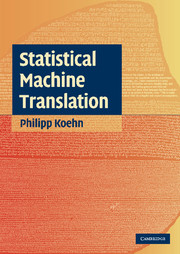10 - Integrating Linguistic Information
from III - Advanced Topics
Published online by Cambridge University Press: 05 June 2012
Summary
The models we have discussed so far make no use of syntactic annotation. Both word-based models (Chapter 4) and phrase-based models (Chapter 5) operate on the surface form of words. In this and the next chapter we discuss methods that attempt to improve the quality of statistical machine translation by exploiting syntactic annotation in various ways. This chapter focuses on methods that extend the phrase-based approach, and the next chapter introduces a new framework that is based on the type of tree structures and grammars that are most commonly used in syntactic theory.
Output from phrase-based systems may look like this (translation from French using Europarl data):
We know very well that the current treaties are not enough and that it will be necessary in future to develop a structure more effective and different for the union, a more constitutional structure which makes it clear what are the competence of member states and what are the powers of the union.
While all the content words are translated correctly and the sentences seems coherent at a local level, there are problems with overall grammaticality. There are problems with the placement of verbs and adjectives, which make the output hard to read.
Information
- Type
- Chapter
- Information
- Statistical Machine Translation , pp. 289 - 330Publisher: Cambridge University PressPrint publication year: 2009
